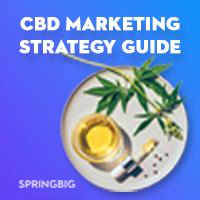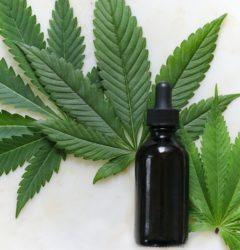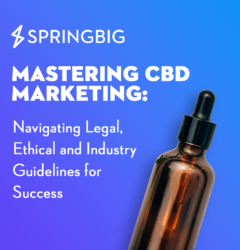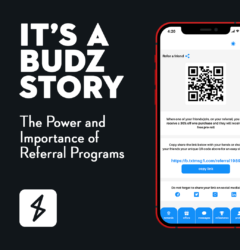
The Latest CBD Industry Trends
Many times, it seems like THC product marketing campaigns write themselves. Upbeat weekend and holiday promotions put customers in the mood to celebrate with their favorite strain.
But don’t discount the increasing power of CBD. According to Statista, 35 percent of Americans will be consuming this cannabinoid by 2024. And a recent Yahoo Finance article predicted that the global CBD oil segment will be worth $15 billion by 2028. It’s a really exciting time to be in the CBD business.
With the CBD market experiencing unprecedented growth, you’ll want to hone your CBD marketing efforts – and that might mean taking a new approach to target customers.
So what kinds of CBD products are flying off the shelves lately? Customers are going for full-spectrum CBD capsules, lotions, and creams, as well as different varieties of CBD oil that may or may not incorporate THC. Gummies are another popular product offered by several CBD brands.
There’s also smokable CBD hemp flower, which, according to Cannabis Business Times, continues to be much cheaper than high-THC cannabis flower. This price differential owes to CBD’s relative novelty and to the fact that THC cannabis is still federally illegal.
Who Is the CBD Consumer?
While younger adults tend to be the most familiar with CBD products, the cannabinoid is increasing in popularity among the 30-64 age group. Many consumers take CBD to help with stress, relieve pain, and counteract insomnia.
We don’t aim to make any medical claims about CBD, but marketing messages that emphasize relaxation and calm might reach your older customers – and increase your CBD business.
With only an estimated 4 percent of boomers currently consuming CBD, there’s plenty of room for your business to grow in this constantly evolving market.
CBD Marketing and Your Target Audience
CBD advertising often includes buzzwords like “wellness,” “organic,” and “premium,” appealing to consumers with more disposable income.
More CBD brands are advertising the purity of their products, their farming practices, and even their third-party lab results. Some are touting their chemical-free production practices. CBD consumers want to know exactly what they are buying.
Older Adults and Your CBD Marketing Campaign
Influencer marketing doesn’t tend to play as central of a role with a more mature demographic. But that’s not to say that older adults aren’t open to new information.
Good old-fashioned word of mouth and referrals from trusted friends, relatives, and dispensaries are essential to an effective CBD marketing strategy.
Information-rich email marketing appeals to older consumers with more time to research their purchases. You can link the product descriptions on your online store to engaging content. Of course, we can help you craft compliant text messages for your content marketing.
The Older Customers and Brand Loyalty
While it might initially be challenging to attract new customers from the boomer and silent generations, many studies indicate that they don’t like to switch stores and brands. So once you’ve reeled them in, retain them with rewards, offers, and freebies of their favorite products.
Referrals always help too. Utilize our Budz customer referral platform, build brand awareness, and have your younger customers entice their relatives with a wide variety of offers and incentives.
Influencer Marketing for the Younger Generation
According to eMarketer.com, 50 percent of Generation Z and Millennial consumers buy products recommended by their favorite content creators on social media platforms.
Online marketing continues to be one of the most important venues to generate new customers, so it should comprise much of your marketing budget.
Broaching the Topic of Topicals
CBD topicals are a great first product for those testing the waters of the cannabis industry. Some older adults might be hesitant to consume edibles or CBD oil, but it is hard not to see the appeal of a luxurious CBD body balm. Who doesn’t need some relief from those daily aches and pains – no matter what your age?
CBD – a Formula for Fido?
This might be surprising, but CBD customers are increasingly treating their pets’ ailments with CBD products. One study saw over 50 percent of pet owners administering it to their furry friends. While most nonhuman CBD consumers were of the canine variety, cats made up over 20 percent of this “target audience.”
Pet products include chews, tinctures, and topicals. Some brands have been marketing CBD oil to stimulate appetite in dogs – one popular CD brand offers roll-on topicals to soothe inflamed paws.
Educational Resources for CBD
Draw the older generation in with educational content stored on our stashboards. There’s always new research on the benefits of marijuana derived CBD, and quality content will generate interest in new cannabis products.
Search Engine Optimization and CBD Marketing
One way that you can generate attention for your dispensary is to link to CBD-related content on your landing pages. Location-specific content, together with CBD marketing keywords, can attract attention by search engines, increasing your SEO rankings.
CBD and THC: It’s Not a Competition
Some of your newer cannabis customers might prefer a CBD-only product, but there are many CBD products that include other cannabinoids, as well as THC products that add CBD. Some of the hottest stress-fighting products on the market contain a blend of CBD, CBG, and THC – so no one has to choose.
A popular Oregon-based CBD brand offers two product lines to enhance sleep: one with a small amount of THC, and one with none.
The CBD Business: More Important Than Ever for Your Dispensary
The bulk of dispensary products has historically been focused on THC products. So, unlike THC companies, CBD businesses have had to overcome the hurdle of a lack of consumer awareness about the cannabinoid.
But increasingly, CBD merchants are surmounting this obstacle. And while federal law prohibits marketing CBD products as dietary supplements, the substance is increasingly available in more oils, lotions, and edibles.
The Future of CBD
We expect increasing organic growth of the CBD market in the foreseeable future. Contact us to learn more about how a CBD campaign can attract new customers – and encourage customer retention.



